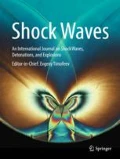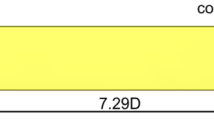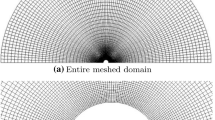Abstract
Numerical study of the shocked flows generated by a supersonic projectile released from a launch tube into a big chamber has been performed in this paper. Based on fixed Cartesian grids, the two-dimensional axisymmetric Euler equations are solved by the fifth-order WENO scheme implemented with moving boundary conditions. Both the level set technique and ghost fluid method are used for capturing the moving interface of the projectile implicitly. The numerical results show that complex shock phenomena exist in the transient shock flow, resulting from shock-wave reflection, shock-wave focusing, shock-wave/projectile interaction and shock-wave/contact surface interactions. The relationships between the acceleration of the projectile and the transient shock flow are also discussed in detail.
Similar content being viewed by others
References
Jiang Z., Huang Y.H., Takayama K.: Wave dynamic processed induced by a supersonic projectile discharging from a shock tube. Phys. Fluids 15(6), 1665–1675 (2003)
Sun M., Takayama K.: The formation of a secondary shock wave behind a shock wave diffracting at a convex corner. Shock Waves 7(5), 287–295 (1997)
Sun M., Siato T., Takayama K.: Unsteady drag on a sphere by shock loading. Shock Waves 14(1–2, 221), 3–9 (2005)
Kim H.D., Setoguchi T.: Study of the discharge of wave shocks from an open end of a duct. J. Sound Vib. 226(5), 1011–1028 (1999)
Bagabir A., Drikakis D.: Numerical experiments using high resolution schemes for unsteady, invisid compressible flows. Comput. Methods Appl. Mech. Eng. 193, 4675–4705 (2004)
Rajesh G., Kim H.D., Matsuo S., Setoguchi T.: A study of the unsteady projectile aerodynamics using a moving coordinates method. J. Aerosp. Eng. 221(5), 691–706 (2007)
Settles, G.S., Grumstrup, T.P., Miller, J.D. Hargather, M.J., Dodson, L.J., Gatto, J.A.: Full-scale high-speed ‘Edgerton’ retroreflective shadowgraphy of explosions and gunshots. In: 5th Pacific Symposium on Flow Visualization and Image Processing, 27–29th September, Australia (2005)
Glass I.I.: Shock Waves and Man. The University of Toronto Press, Toronto (1974)
Matsummura T., Funabashi S., Taitoh T., Takayama K.: A holographic interferometric study of the axisymmetric supersonic flow around a cylindrical projectile. Rep. Ins. Fluid Sci. Tohoku Univ. 5, 89–97 (1993)
Jiang Z., Takayama K.: Numerical study on blast flow fields induced by supersonic projectiles discharged from shock tubes. Phys. Fluids 10(1), 277–288 (1998)
Jiang X.H., Chen Z.H., Fan B.C., Li H.Z.: Numerical simulation of blast flow fields induced by a high-speed projectile. Shock Waves 18(3), 205–212 (2008)
Cler, D.L., Chevaugeon, N., Shephard M.S., Remacle, J.F.: CFD application to gun muzzle blast-a validation case study. AIAA Paper, No. 2003–1142 (2003)
Rajesh G., Kim H.D., Setotuchi T.: Projectile aerodynamics overtaking a shock wave. J. Spacecr. Rockets 45(6), 1251–1261 (2008)
Jiang G.S., Shu C.W.: Efficient implementation of weighted ENO schemes. J. Comput. Phys. 126(1), 202–228 (1996)
Sussman M., Smereka P., Osher S.: A level set approach for computing solutions to incompressible two-phase flow. J. Comput. Phys. 114(1), 146–159 (1994)
Osher S., Sethian J.: A Fronts propagating with curvature-dependent speed: algorithm as based on Hamilton–Jacobi formulations. J. Comput. Phys. 79(1), 12–49 (1988)
Fedkiw R., Aslam T., Merriman B., Osher S.: A non-oscillatory Eulerian approach to interfaces in multi-material flows (the Ghost Fluid Method). J. Comput. Phys. 152(2), 457–492 (1999)
Sod G.A.: A numerical study of a converging cylindrical shock. J. Fluid Mech. 83(4), 785–794 (1977)
Shu C.W., Osher S.: Eifficient implementation of essentially non-oscillatory shock-capturing shceme. J. Comput. Phys. 77(2), 439–471 (1988)
Liu X.D., Osher S., Chan T.: Weighted essentially non-oscillatory schemes. J. Comput. Phys. 115(1), 200–212 (1994)
Author information
Authors and Affiliations
Corresponding author
Additional information
Communicated by O. Igra.
Rights and permissions
About this article
Cite this article
Zhang, B., Liu, H., Chen, F. et al. Numerical simulation of flow fields induced by a supersonic projectile moving in tubes. Shock Waves 22, 417–425 (2012). https://doi.org/10.1007/s00193-012-0389-4
Received:
Revised:
Accepted:
Published:
Issue Date:
DOI: https://doi.org/10.1007/s00193-012-0389-4




